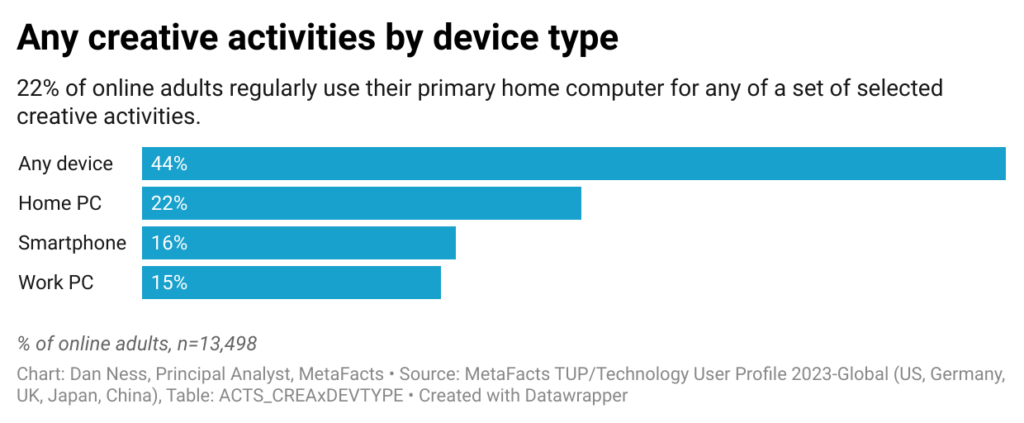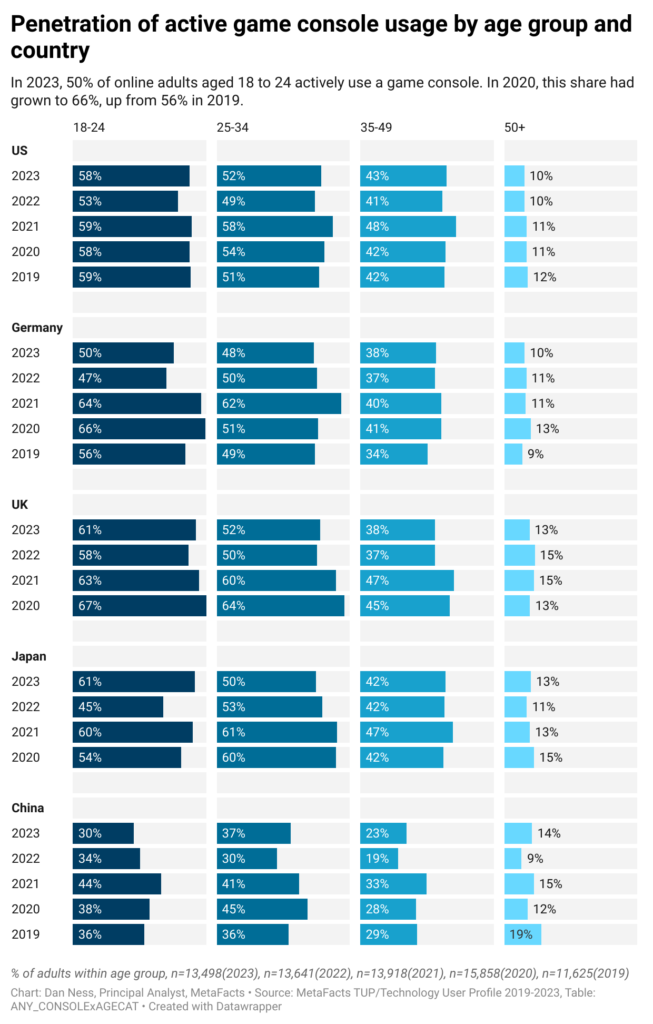During the pandemic, the rapid flight to health, safety, and remote work caught many employers’ IT departments unprepared. Many workers did not have employer-provided computers or even home-owned ones, although the majority had smartphones. At the same time, much of the online population was already migrating many of their everyday activities away from computers to smartphones. Consequently, roughly half of online adults in the US and UK, and over 40% of those in Germany and Japan, regularly use their smartphones for work-related activities.
This MetaFAQ reports on the percentage of online adults that use a smartphone for a range of work-related activities, from checking email and participating in online meetings to phone and video calls. Report [TUP_doc_2024_0123_spwt] in TUP Lenses: Mobile Phones; Activities; Communication; Work/Life Balance
Creative activities niche may underpin AI for some
Dan Ness, Principal Analyst, MetaFacts, January 22, 2024
Summary
Generative AI has received much attention, and much of the hyperbole around widespread adoption rests on the assumption that people will suddenly become creative. A more likely adoption scenario is that the users already actively creating content will be the first to incorporate any AI into their workflows.
This MetaFAQs reports on the percentage of online adults worldwide and in the US who regularly do any of a set of selected creative activities—creating graphics or presentations or using professional creative software—further split by whether the activities are for personal or work-related needs. This is split by device type, age, and generation and trended from 2020 to 2023.
No single device type is used by creatives
- Four in nine online adults regularly do any of a set of creative activities – creating graphics or presentations or using professional creative software
- Half of these users (22% of online adults) regularly use a home computer for these creative activities
- Work computers being used for creative activities only make up 15% of online adults
- A small share actively uses more than one type of device

Game consoles continue among the young at heart after an early pandemic surge
Dan Ness, Principal Analyst, MetaFacts, January 16, 2024
Summary
The active use of a game console is primarily the domain of younger adults. However, the entertainment devices are not limited to the youngest adults as market penetration remains nearly as high among 40-somethings as among the age 18 to 24 adult. Following the onset of the pandemic, game console penetration reached new highs among most age groups and countries, only to settle back towards historical levels.
This MetaFAQs reports on the percentage of online adults actively using a game console split by age group and country.
Game console penetration by age group and country
- The active use of game consoles is skewed towards adults under age 50
- The age skew is not especially steep, as market penetration among adults aged 35 to 49 is roughly 40% in the US, Germany, the UK, and Japan
- Among most countries and age groups, game console penetration peaked in 2020 and 2021 following the onset of the pandemic and has since settled

Gen Z and Millennial voices are heard, by assistants
Voice commands preceded the hype of AI with the promise that technology users would be able to get things done with their voices. Market reception was robust initially, then sagged, and has since returned to moderate levels among certain age groups. A skew toward higher market penetration among younger adults is apparent in the US and UK but less in Germany and China.
This MetaFAQs reports on the percentage of online adults who use a voice assistant through their primary connected device – a smartphone, computer, tablet, or game console, divided by age group and country. Report [TUP_doc_2024_0113_yvoi] in TUP Lenses: Mobile Phones; Consumer Electronics; User Profile; Activities; Technology Ecosystems; Wearables, Hearables, Listening, and Speaking
Generation gap in home computer use for work
Following the onset of the pandemic, remote working suddenly became more widespread. Varied levels of remote working continue, although the situation continues to be in flux as employers shift their policies. To continue to be productive, many remote workers pressed their home computers into the service of their employer, regularly using them for work-related activities. Interestingly, in most countries surveyed, a higher share of younger adults use home computers for work than older adults do.
This MetaFAQs reports on the percentage of online adults using a home computer for work-related activities, from videoconferencing to preparing reports or presentations. Report [TUP_doc_2024_0107_yhwk] in TUP Lenses: User Profile; Households; Activities; Work/Life Balance
Smaller employers rely on workers’ home PCs
During the pandemic, as workers began to work from home, they shifted rapidly to use whatever technology they had. Even after many employees have returned to the workplace, whether on a regular or hybrid basis, the share of workers using a home PC for work continues to outnumber those using an employer-provided PC. The trend in the gap between home and work PCs has narrowed within some sectors, namely in the US and Japan among larger employers, and remains wide among smaller employers around the world.
This MetaFAQ reports on the percentage of workers – full-time, part-time, or self-employed – who use a home PC for work-related activities as compared to those using a work PC for work-related activities, split by the size of the employer. Report [TUP_doc_2024_0103_byot] in TUP Lenses: PCs; User Profile; Activities; Work/Life Balance
Modern communication shifts to coalesce around three modes
Communication methods have evolved over the past few decades. While landlines were once predominant, they’ve now taken a back seat. Asynchronous communication, like email, offers the advantage of connecting without simultaneous availability, often more convenient and effective. Text messaging, in particular, has experienced a significant rise, now standing as a leading communication method alongside emails.
Interestingly, while smartphones are labeled “”phones,”” their initial use leaned more toward texting than calling. However, synchronous communication methods are making a comeback on these devices. Email, text messaging, and phone calls share nearly equal user numbers, showcasing varied preferences among users.
Our communication choices often depend on reciprocation, given its two-way nature. As a result, user groups may flock together toward specific communication modes, either adopting new methods or moving away from older ones.
Later generations, specifically Gen Z, have been experimenting with alternative communication modes beyond email, texting, and phone calls, only recently returning to levels nearly as high as those before the onset of the pandemic. Earlier generations have increased their use of these three communication modes even while navigating a shift from computers to smartphones.
This TUPdate reports on the share of online adults using their connected devices for any of the three major communication activities – personal phone calls, emails, or text messages. It reports on the trends from 2017 through 2023, highlighting the shifts that took place following the onset of the pandemic. Furthermore, it details the differences in communication behaviors between generational age groups. Report [TUP_doc_2023_1212_comt] in TUP Lenses: Activities; Communication
Gen Z’s lead in online teamwork may transform the workplace
Digital collaboration has expanded over a decade, with newer generations adopting online teamwork swiftly. Gen Z, especially in the US and UK, actively collaborates on personal files, more so than for work. Current workplace practices limit their broader collaboration. Yet, they might pave the way for enhanced collaborative tool usage in the future.
This MetaFAQs reports on the use of connected device to collaborate on files, splitting the activity by work-related and personal files, and splitting further into generational age groups and countries. Report [TUP_doc_2023_1209_coll] in TUP Lenses: User Profile; Activities; Work/Life Balance
Half of Gen Z Americans use a game console, unlike elders
Later generations heavily favor game consoles. Only a fourth of Gen X has embraced game consoles, while most millennials and Gen Z generations actively play with them. Console games are intriguing to these later generations for their immersion, demanding video, and the social aspect of sharing game-playing.
This MetaFAQs reports the percentage of online adults in the US, Germany, UK, Japan, and China using a game console by generation. Report [TUP_doc_2023_1203_cons] in TUP Lenses: User Profile; Activities; Game Consoles, Gaming PCs, and Game-Playing
Half of Americans use a smartphone for work
Half of Americans use a smartphone for work – Over half of online American adults utilize smartphones for various work tasks, from emails to videoconferencing. One in six American workers relies solely on a smartphone. Another quarter have all three: a smartphone, computer and tablet, and 80% of these rely on smartphones for work activities. Interestingly, half lack employer-provided computers.
This MetaFAQs reports on the percentage of online adults regularly using a smartphone for work-related activities. Report [TUP_doc_2023_1125_spwr] in TUP Lenses: Mobile Phones; Activities; Communication; Work/Life Balance

